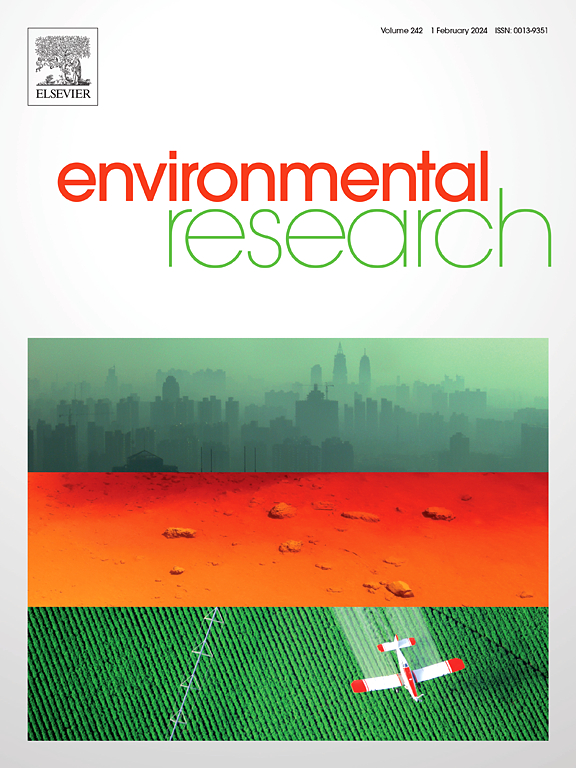通过真菌-细菌共培养提高生物氧化锰产量并去除Cd(II)和环丙沙星。
IF 7.7
2区 环境科学与生态学
Q1 ENVIRONMENTAL SCIENCES
引用次数: 0
摘要
微生物共培养是提高代谢物生产和功能能力的一种很有前途的策略。虽然大多数关于生物锰氧化(BMO)的研究都集中在单个细菌或真菌菌株上,但真菌-细菌共同培养的潜在益处在很大程度上仍未被探索。本研究系统研究了氧化锰真菌Cladosporium sp. XM01与氧化锰细菌Bacillus sp. XM02共培养对Mn(II)氧化的协同效应。结果表明,共培养显著提高了细胞总生物量,提高了Mn(II)的去除率。最佳条件是延迟菌株XM02的引入36 h,并保持2:1的共培养比例(XM01:XM02)。在共培养系统中观察到的Mn(II)氧化增强归因于超氧化物歧化酶和过氧化氢酶的活性增加,这有助于维持氧化还原稳态并维持超氧化物的产生-锰(II)生物氧化的必需氧化剂。扫描电镜显示芽孢杆菌sp. XM02细胞附着在枝孢杆菌sp. XM01菌丝上,形成有结构的菌群。这些聚集体表明强烈的物理相互作用可能促进了营养交换和代谢合作。此外,去除动力学实验表明,与纯培养的BMO相比,共培养产生的BMO具有更好的Cd(II)吸附能力和环丙沙星氧化性能。这种增强与共培养BMO的高比表面积和平均氧化态(Mn-AOS)增加有关,这增强了其吸附和氧化反应活性。这些发现为锰氧化微生物之间的共生相互作用提供了新的见解,并突出了真菌-细菌共培养作为增强锰氧化微生物环境修复功能的有效策略的潜力。本文章由计算机程序翻译,如有差异,请以英文原文为准。
Enhanced biogenic manganese oxide production and the removal of Cd(II) and ciprofloxacin via fungus-bacterium co-cultivation
Microbial co-cultivation is a promising strategy for enhancing metabolite production and functional capabilities. While most research on biogenic manganese (Mn) oxidation (BMO) has focused on individual bacterial or fungal strains, the potential benefits of fungal-bacterial co-cultivation remain largely unexplored. In this study, the synergistic effects of co-culturing the Mn-oxidizing fungus Cladosporium sp. XM01 with the Mn-oxidizing bacterium Bacillus sp. XM02 on Mn(II) oxidation were systematically investigated. The results showed that co-cultivation significantly increased total cell biomass and enhanced Mn(II) removal. Optimal conditions were achieved by introducing strain XM02 with a 36 h delay and maintaining a co-culturing ratio of 2:1 (XM01:XM02). The enhanced Mn(II) oxidation observed in the co-culture system was attributed to increased activities of superoxide dismutase and catalase, which help maintain redox homeostasis and sustain the production of superoxide—an essential oxidant in Mn(II) bio-oxidation. Scanning electron microscopy revealed that Bacillus sp. XM02 cells were attached to the hyphae of Cladosporium sp. XM01, forming structured fungal-bacterial aggregates. These aggregates suggest strong physical interactions that likely facilitated nutrient exchange and metabolic cooperation. Additionally, removal kinetics experiments showed that BMO produced in the co-culture exhibited superior Cd(II) adsorption capacity and ciprofloxacin oxidation performance compared to BMO derived from pure cultures. This enhancement was linked to the higher specific surface area and increased average oxidation state (Mn-AOS) of the co-culture BMO, which enhanced its adsorption and oxidative reactivity. These findings provide new insights into the symbiotic interactions among Mn-oxidizing microorganisms and highlight the potential of fungal-bacterial co-cultures as an effective strategy to enhance BMO functionality for environmental remediation.
求助全文
通过发布文献求助,成功后即可免费获取论文全文。
去求助
来源期刊

Environmental Research
环境科学-公共卫生、环境卫生与职业卫生
CiteScore
12.60
自引率
8.40%
发文量
2480
审稿时长
4.7 months
期刊介绍:
The Environmental Research journal presents a broad range of interdisciplinary research, focused on addressing worldwide environmental concerns and featuring innovative findings. Our publication strives to explore relevant anthropogenic issues across various environmental sectors, showcasing practical applications in real-life settings.
 求助内容:
求助内容: 应助结果提醒方式:
应助结果提醒方式:


